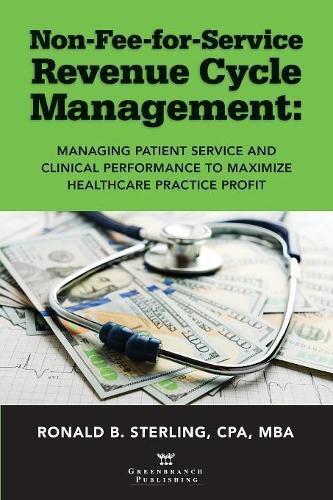Readings Newsletter
Become a Readings Member to make your shopping experience even easier.
Sign in or sign up for free!
You’re not far away from qualifying for FREE standard shipping within Australia
You’ve qualified for FREE standard shipping within Australia
The cart is loading…






This title is printed to order. This book may have been self-published. If so, we cannot guarantee the quality of the content. In the main most books will have gone through the editing process however some may not. We therefore suggest that you be aware of this before ordering this book. If in doubt check either the author or publisher’s details as we are unable to accept any returns unless they are faulty. Please contact us if you have any questions.
Non-Fee-for-Service Revenue Cycle Management: Managing Patient Service and Clinical Performance to Maximize Healthcare Practice Profit
By Ronald B. Sterling, CPA, MBA
As the healthcare system migrates from the fee for service (FFS) model to a variety of non-fee for service (non-FFS) payment systems, practices/HCOs will be seeking strategies and tactics to fill the care gaps that exist because of the fee for service model. From more active patient engagement to establishing and maintaining collaborative patient and provider relations, practices/HCOs need to rethink their own added value strategies and how to best serve healthcare stakeholders including patients, patient caregivers, physicians and other providers.
Consequentially, practices/HCOs will need to modify a variety of processes, strategies, and tools. Using existing FFS focused tactics could inhibit the ability to analyze clinical and/or financial performance.
2017
From managing services that generate revenue to the billing process and tracking clinical and business performance, the non-FFS models present resource, patient service, billing, and reporting challenges.
In today’s high-stakes healthcare practice business climate, physician leaders and healthcare organization will need to answer the following questions:
What are the clinical and operational requirements to earn the non-FFS revenue?
How will the practice/HCO track clinical performance and patient service that could impact non-FFS revenue?
What are the costs incurred in producing the non-FFS revenue?
How will the practice/HCO verify that the non-FFS payment is correct?
How will non-FFS revenue be credited to physicians in calculating their compensation?
What are the analytical tools needed to evaluate the financial performance of the non-FFS arrangement?
The Non-Fee for Service reimbursement changes for healthcare practices are a business challenge that you cannot afford to ignore. These transformative challenges must be addressed for health care organizations to succeed in the coming years. Leveraging his extensive knowledge of healthcare information technology and accounting, Ron Sterling provides a complete view on how to track and manage Non-FFS reimbursement and how to capitalize on the financial opportunities of Non-FFS arrangements.
$9.00 standard shipping within Australia
FREE standard shipping within Australia for orders over $100.00
Express & International shipping calculated at checkout
This title is printed to order. This book may have been self-published. If so, we cannot guarantee the quality of the content. In the main most books will have gone through the editing process however some may not. We therefore suggest that you be aware of this before ordering this book. If in doubt check either the author or publisher’s details as we are unable to accept any returns unless they are faulty. Please contact us if you have any questions.
Non-Fee-for-Service Revenue Cycle Management: Managing Patient Service and Clinical Performance to Maximize Healthcare Practice Profit
By Ronald B. Sterling, CPA, MBA
As the healthcare system migrates from the fee for service (FFS) model to a variety of non-fee for service (non-FFS) payment systems, practices/HCOs will be seeking strategies and tactics to fill the care gaps that exist because of the fee for service model. From more active patient engagement to establishing and maintaining collaborative patient and provider relations, practices/HCOs need to rethink their own added value strategies and how to best serve healthcare stakeholders including patients, patient caregivers, physicians and other providers.
Consequentially, practices/HCOs will need to modify a variety of processes, strategies, and tools. Using existing FFS focused tactics could inhibit the ability to analyze clinical and/or financial performance.
2017
From managing services that generate revenue to the billing process and tracking clinical and business performance, the non-FFS models present resource, patient service, billing, and reporting challenges.
In today’s high-stakes healthcare practice business climate, physician leaders and healthcare organization will need to answer the following questions:
What are the clinical and operational requirements to earn the non-FFS revenue?
How will the practice/HCO track clinical performance and patient service that could impact non-FFS revenue?
What are the costs incurred in producing the non-FFS revenue?
How will the practice/HCO verify that the non-FFS payment is correct?
How will non-FFS revenue be credited to physicians in calculating their compensation?
What are the analytical tools needed to evaluate the financial performance of the non-FFS arrangement?
The Non-Fee for Service reimbursement changes for healthcare practices are a business challenge that you cannot afford to ignore. These transformative challenges must be addressed for health care organizations to succeed in the coming years. Leveraging his extensive knowledge of healthcare information technology and accounting, Ron Sterling provides a complete view on how to track and manage Non-FFS reimbursement and how to capitalize on the financial opportunities of Non-FFS arrangements.